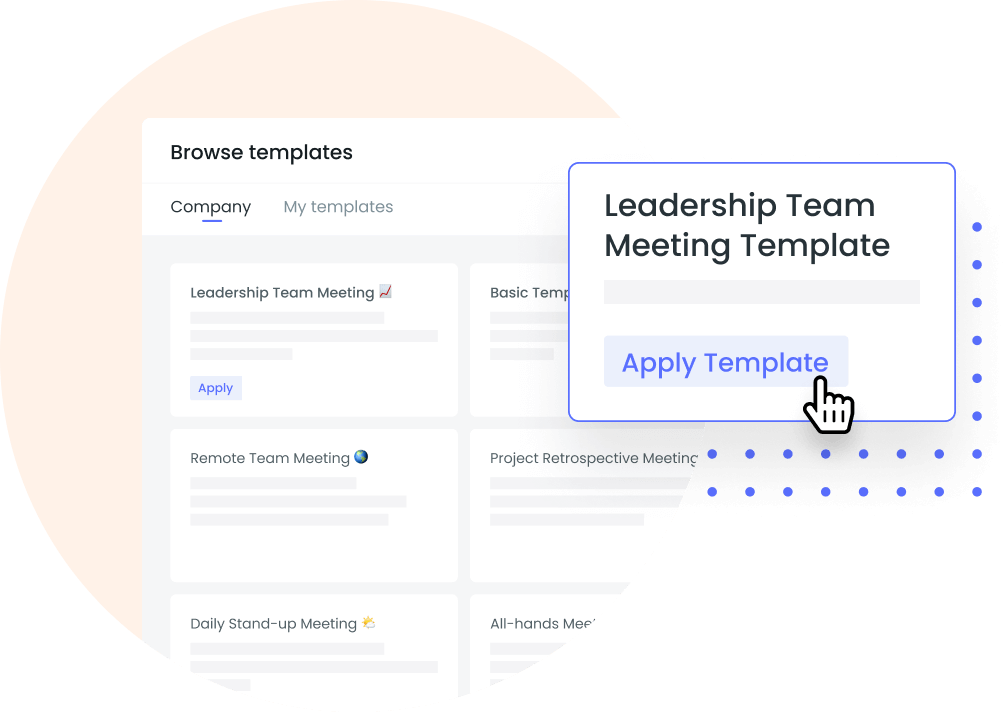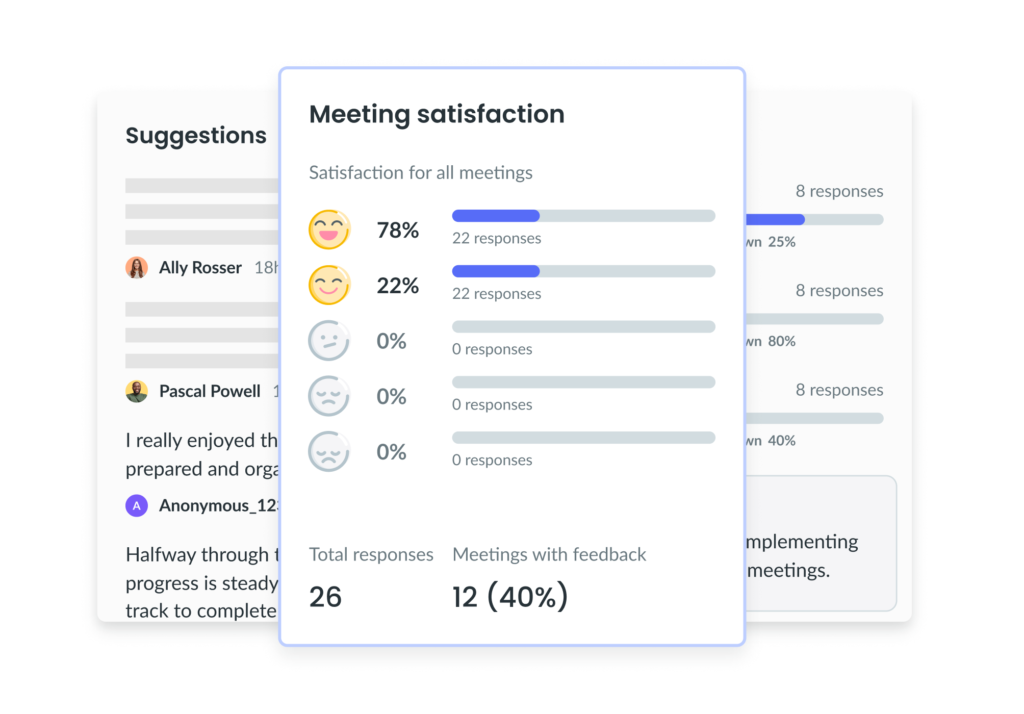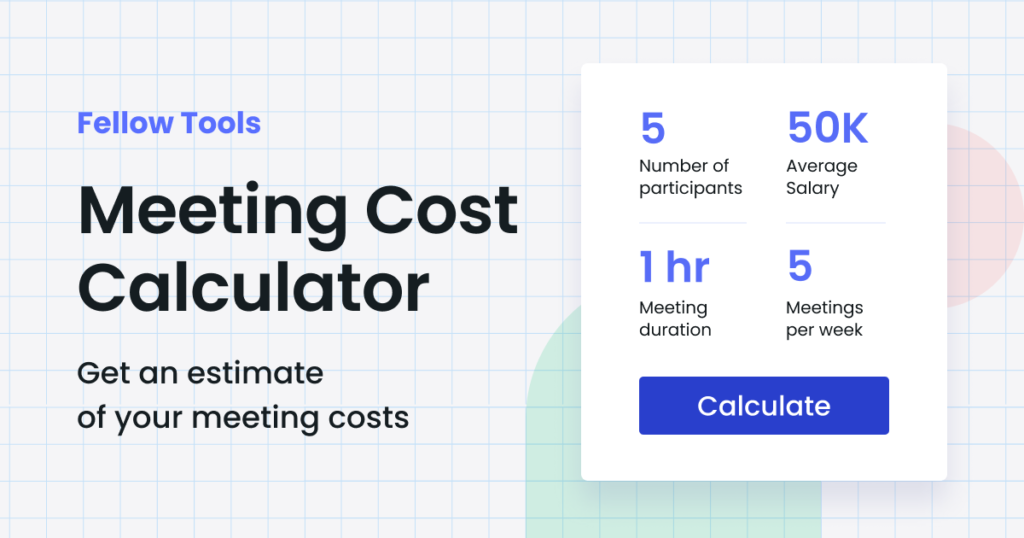How to Analyze Your Meetings: Best Practices
Learn how to use your meeting agendas, notes, and recaps to analyze your meetings and make better decisions.
Great business outcomes are the result of great team collaboration. As a leader or manager, you should strive to make your meetings as efficient as possible. One way to ensure each meeting is productive is by regularly analyzing the different parts of each session to evaluate the success of your team’s overall meeting strategy.
Read on to learn why you should analyze each meeting, explore four aspects of a meeting you can analyze, view our best practices for analyzing meetings, and see how you can use Fellow to host meetings that drive action and get results.
- Why should you analyze your meetings?
- 4 parts of a meeting you can analyze
- Best practices for analyzing your meetings
- How to analyze your meetings with Fellow
Why should you analyze your meetings?
Improves meeting productivity
It’s simple: When you discover what works well for your team and what’s slowing you down, you’ll be better equipped to run more productive meetings. Following each meeting, identify what went well, what agenda items attendees spent the most time on, and how you can make meetings more efficient in the future. Then, develop a plan with action items and a timeline to facilitate better sessions moving forward. Productive meetings will result in better decisions, relationships, and improved team morale.
Improves decision making
Analyzing your meetings will force you to take a step back and evaluate your team’s decision-making processes. Use your meeting review sessions to assess how your team makes decisions and determine where the group can improve. Perhaps you’ll learn that you and your colleagues spend too much time debating small decisions during team meetings that waste precious hours each month. With this new information, your team can make faster, more informed decisions that involve fewer stakeholders.
Improves collaboration and participation
Reviewing and analyzing past agendas and notes will help you view how you collaborate with teammates and who participates most frequently in group discussions. Analyze past meetings to find out how often different teammates interact during virtual and in-person meetings and to develop a plan to improve your team’s collaboration. You may discover that one colleague regularly goes off-topic during project meetings or notice that another teammate has a difficult time speaking up when called upon. Use the information you uncover during your analysis to improve your team’s culture, foster open communication, help employees who struggle to contribute their ideas within group settings, and best communicate your expectations for collaboration moving forward.

Gain insight into your company’s meeting productivity patterns
With Fellow’s Analytics, important meeting and collaboration patterns in your organization are brought to the forefront. You can quickly see the number of meetings per day by type, size, length and more!

4 parts of a meeting you can analyze
Meeting agendas
Having detailed and collaborative meeting agendas is one of the best ways to facilitate great decision-making. You can optimize your meetings by regularly reviewing and altering your agendas to meet your team’s needs. After each meeting with a teammate or group, evaluate which items were necessary, which weren’t, and what talking points you should add to future meetings.
If you consistently use the same meeting agenda template, try switching it up. Use one of Fellow’s 500+ ready-to-use meeting agenda templates to guide your one-on-ones, connect with your team, and kick off projects.

Meeting outcomes
In your meeting minutes or notes, a designed notetaker should write a summary that documents key outcomes and action items. Meeting outcomes can also include decisions on resource allocation and plans for the future. Analyze your meeting outcomes to determine whether each meeting was worth the required time and effort.
For example, if you recently hosted a meeting to discuss an upcoming project but realized during the meeting analysis phase that there were no important outcomes, you’ll know that you and your colleagues should do additional prep work in advance of your next meeting. Contrarily, if there were many key takeaways from one meeting, it may mean that you should host more than one meeting about the same topic in the future.
Meeting punctuality
Punctual behavior improves efficiency. By beginning meetings on time, everyone can begin their duties earlier and the session can end sooner. Meeting punctuality means respecting your colleagues by arriving on time, and it demonstrates timeliness and assures teammates that they can count on you to complete your work by the deadline you agreed upon. Punctuality also means starting meetings on time, every time.
Review meeting minutes to determine how many of your meetings are beginning on time and to see how frequently members of the team are showing up on time. Use this information to develop a plan that encourages punctuality for meeting hosts, organizers, and attendees. Remember, beginning meetings later than the outlined time indicates to attendees that their time isn’t valued, so always aim to start yours on schedule.
Meeting feedback
Meeting feedback is an important tool you can use to improve the quality of your meetings and refine your skills. Feedback can also help identify if your meetings are reaching the intended goals. As a leader, you should ask for regular meeting feedback to make sure your meetings are hitting their mark. Host a quick feedback session at the end of your next team meeting or send a post-meeting survey to gather information about what went well and what you can improve on in the future.
At Fellow, we recognize that meetings are one of the greatest collaboration tools. Use our tool to share real-time feedback on meetings, projects, and performance. Incorporate new opportunities to give and receive meeting feedback each day and keep a history of the feedback so your team members can visualize their growth!

Best practices for analyzing your meetings
- Ask for meeting feedback
- Keep track of your meetings
- Monitor meeting etiquette
- Identify collaboration patterns
1Ask for meeting feedback
Measure the effectiveness of each session by asking for regular meeting feedback. The most popular ways to gather feedback from teammates are by asking questions at the end of a meeting or in a post-meeting survey. Questions like, “How would you rate today’s meeting on a scale of 1 to 10?” or “What would you do to make our team meetings more productive?” can help you improve the quality of your meetings, refine your skills as the meeting host and organizer, and ensure each meeting reaches its intended objectives.

2Keep track of your meetings
While meetings can help your team coordinate work and generate new ideas, too many meetings can harm your team’s productivity. Keep track of how many meetings you and your teammates have every week. At the end of each meeting, determine whether the meeting takeaways were worth the time it took out of your and your colleagues’ day.
Did you know teams that use Fellow spend 16% less time in meetings? See how much your meetings currently cost with our meeting cost calculator.
3Monitor meeting etiquette
Etiquette improves communication and can help establish mutual respect between colleagues. Meeting etiquette refers to behaviors like being on time, actively listening without interrupting colleagues, and coming to each session prepared and ready to participate. When analyzing meetings, evaluate your team’s etiquette to see if there’s room for improvement. For example, if you notice that your teammates like to multitask or use their phones during meetings, you can use your meeting analysis to develop feedback that encourages everyone to be present and stay on-task.
4Identify collaboration patterns
Collaboration is an essential part of problem-solving and decision-making. When analyzing your meetings, look for patterns that identify problems like meeting overload, inefficiencies, and collaboration issues. Review meeting notes, minutes, and recaps to see who is contributing frequently to the conversation and who could be participating more. Use this information to deliver positive and constructive feedback.
Feedback is a two-way street, so don’t forget to ask your teammates how they like to collaborate as well. Use their feedback to determine how you can best work with your employees’ strengths, create a supportive work environment, and see whether you need to implement new asynchronous meeting tools like instant messaging apps, asynchronous communication tools, project management software, or video conferencing tools.
How to analyze your meetings with Fellow
Gain insight into your company’s meeting productivity patterns and visualize your team’s collaboration using Fellow. Using our Analytics feature, you can bring essential meeting and collaboration patterns to the forefront to identify problems and create guidelines that improve productivity.
Based on your analysis, you can then use Fellow to build collaborative meeting agendas, record decisions, and hold your teammates accountable for their action items. Try Fellow today to organize your ideas, record notes, and exchange meaningful feedback with your teammates!

Parting advice
When you think of analysis, meetings probably aren’t the first thing that comes to mind. However, analysis is one of the best ways to highlight issues facing your team and develop effective solutions.
If you want to improve your team’s productivity, start by analyzing your meetings. Use your previous agendas, notes, and meeting recaps to determine how you and your colleagues can reach new heights and achieve new goals!












